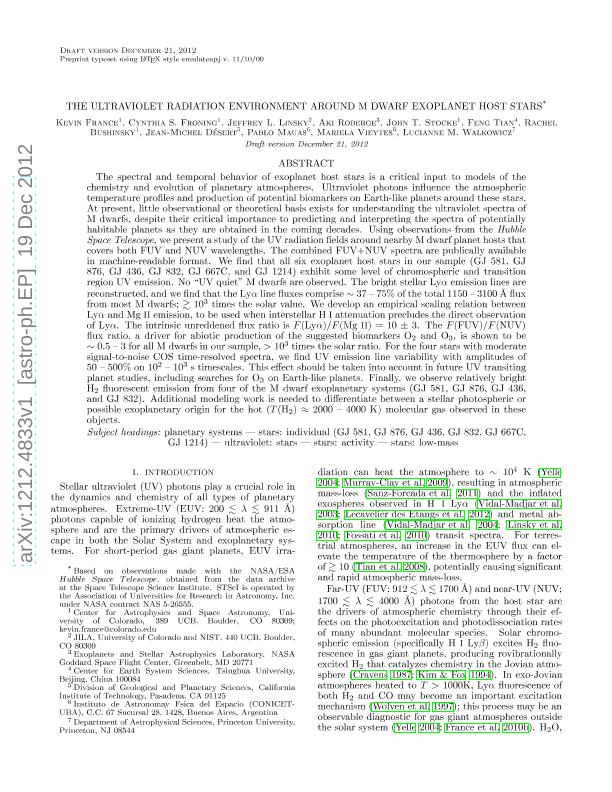Artículo
The Ultraviolet Radiation Environment around M dwarf Exoplanet Host Stars
France, Kevin; Froning, Cynthia S.; Linsky, Jeffrey L.; Roberge, Aki; Stocke, John T.; Tian, Feng; Bushinsky, Rachel; Déser, Jean-Michel; Mauas, Pablo Jacobo David ; Vieytes, Mariela Cristina
; Vieytes, Mariela Cristina ; Walkowicz, Lucianne M.
; Walkowicz, Lucianne M.
 ; Vieytes, Mariela Cristina
; Vieytes, Mariela Cristina ; Walkowicz, Lucianne M.
; Walkowicz, Lucianne M.
Fecha de publicación:
02/2013
Editorial:
IOP Publishing
Revista:
Astrophysical Journal
ISSN:
0004-637X
Idioma:
Inglés
Tipo de recurso:
Artículo publicado
Clasificación temática:
Resumen
The spectral and temporal behavior of exoplanet host stars is a critical input to models of the chemistry and evolution of planetary atmospheres. Ultraviolet photons influence the atmospheric temperature profiles and production of potential biomarkers on Earth-like planets around these stars. At present, little observational or theoretical basis exists for understanding the ultraviolet spectra of M dwarfs, despite their critical importance to predicting and interpreting the spectra of potentially habitable planets as they are obtained in the coming decades. Using observations from the Hubble Space Telescope, we present a study of the UV radiation fields around nearby M dwarf planet hosts that covers both far-UV (FUV) and near-UV (NUV) wavelengths. The combined FUV+NUV spectra are publicly available in machine-readable format. We find that all six exoplanet host stars in our sample (GJ 581, GJ 876, GJ 436, GJ 832, GJ 667C, and GJ 1214) exhibit some level of chromospheric and transition region UV emission. No "UV-quiet" M dwarfs are observed. The bright stellar Lyα emission lines are reconstructed, and we find that the Lyα line fluxes comprise ∼37%-75% of the total 1150-3100 Å flux from most M dwarfs; ≳103 times the solar value. We develop an empirical scaling relation between Lyα and Mg II emission, to be used when interstellar H I attenuation precludes the direct observation of Lyα. The intrinsic unreddened flux ratio is F(Lyα)/F(Mg II) = 10 ± 3. The F(FUV)/F(NUV) flux ratio, a driver for abiotic production of the suggested biomarkers O2 and O3, is shown to be ∼0.5-3 for all M dwarfs in our sample, >103 times the solar ratio. For the four stars with moderate signal-to-noise Cosmic Origins Spectrograph time-resolved spectra, we find UV emission line variability with amplitudes of 50%-500% on 102-103 s timescales. This effect should be taken into account in future UV transiting planet studies, including searches for O 3 on Earth-like planets. Finally, we observe relatively bright H 2 fluorescent emission from four of the M dwarf exoplanetary systems (GJ 581, GJ 876, GJ 436, and GJ 832). Additional modeling work is needed to differentiate between a stellar photospheric or possible exoplanetary origin for the hot (T(H2) ≈ 2000-4000 K) molecular gas observed in these objects.
Archivos asociados
Licencia
Identificadores
Colecciones
Articulos(IAFE)
Articulos de INST.DE ASTRONOMIA Y FISICA DEL ESPACIO(I)
Articulos de INST.DE ASTRONOMIA Y FISICA DEL ESPACIO(I)
Citación
France, Kevin; Froning, Cynthia S.; Linsky, Jeffrey L.; Roberge, Aki; Stocke, John T.; et al.; The Ultraviolet Radiation Environment around M dwarf Exoplanet Host Stars; IOP Publishing; Astrophysical Journal; 763; 149; 2-2013; 149-163
Compartir
Altmétricas



